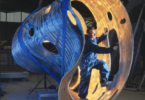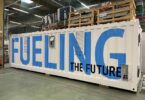Every year another 500,000 people migrate from the countryside to sprawling South American cities like São Paulo. Many end up in favelas that either have no power or rely on illegal, often dangerous, electricity hook-ups.
Enel, a global energy company headquartered in Rome that generates and distributes electricity in 30 countries on five continents, is tackling the energy poverty problem by using a strategy which focuses on community involvement, renewable energy, and a circular economy approach.
In São Paulo, thanks to a partnership between the energy company and an NGO, Enel improved community life in slums with high crime rates by adding public streetlights. The streetlights were constructed by locals from green material: an electric circuit made using recycled parts, an LED, a recycled plastic bottle as a bulb, a solar panel for power generation and a rechargeable lithium battery to guarantee night-time lighting. In the suburban areas of Chile’s capital, Santiago, Enel provides solar-powered public lighting to residents of three slum communities and rural electrification for twelve more, as part of a project that includes social programs and Enel workshops on energy efficiency and electrical risk. And in Bogota and Cundinamarca, it is not just about connecting Colombia’s favelas to the grid: Enel tries through various projects to ensure the population is educated to understand their bills and teaches people the importance of the safe use of energy and the various uses of mobile phones.
Enel’s approach is based on the company’s ‘Open Power’ motto: opening energy access to more people; opening the world of energy to new technologies; opening new ways for people to manage energy; opening new uses of energy and opening more partnerships. To achieve those goals Enel has directed its activities towards mitigating climate change through decarbonizing the production and consumption of energy, while simultaneously extending access to affordable and clean energy, addressing two of the UN’s Sustainable Development Goals (SDGs 7 and 13).
To the cynical this may sound like corporate social responsibility publicity stunts and green washing, but the numbers tell a different story. Through this approach Enel has managed to shrink direct emissions by more than half over the last ten years while growing revenue. Renewables now make up 47.9%, up from just 8% a decade ago. Enel expects its total portfolio to be more than 85% renewable by 2030 and at Net-Zero, for both direct and indirect emissions, by 2040. That’s 10 years earlier than the goal Enel set for itself in 2015, when it signed on to the United Nations’ SDGs.
Its progress is an example of how the energy transition offers enormous opportunities to not only shape the future of the global energy system but also to address some of the world’s most pressing challenges through concrete actions.
“Our goal is not innovation per se but innovation that is managed for impact, so that we are not just doing good for the company but for society-at-large,” Michele Crisostomo, Enel’s Chair of the Board of Directors and of the Corporate Governance and Sustainability Committee, said during an interview with The Innovator in Davos.
Creating Shared Value
Enel’s strategy is based in part on “Creating Shared Value”, the idea that companies are successful when the communities in which they are embedded are also prospering.
The approach was initially developed within Enel Green Power. Francesco Starace and Alberto De Paoli, Chief Executive Officer and Chief Financial Officer of Enel Green Power at the time, realized early on that sustainability was key for growing renewable power generation. Since the development of renewable energy projects involve a continuous presence in and engagement with local communities Enel Green Power worked on translating Creating Shared Value (CSV) from “an academic concept into a practical model for understanding societal needs in specific local contexts,” according to a case study on Enel’s strategy prepared by Oxford University’s Said Business School.
For example, Enel developed Cerro Pabellón, the only geothermal plant in Chile, and fostered the creation of social enterprises that offered employment opportunities to indigenous communities. The Cerro Pabellón project was also awarded the “Seal of Excellence” by the Chilean Ministry of the Environment for effectively managing and mitigating its environmental footprint during its construction phase.
After becoming Enel Group CEO and CFO in 2014, Starace and De Paoli scaled up the CSV model to the Enel Group. Today the model and a circular economy approach are embedded into Enel’s entire value chain.
To ensure the integration of the model in all its subsidiaries, Enel established dedicated sustainability functions in each of its global business lines. The people in these roles are responsible for adapting the global CSV procedures and guidelines to local conditions and specific business contexts. An important element of the application of the model are tools that define shared value and how to capture it, notes the case study. These tools include a library of sustainable actions, organized by technologies, that engineers can use to mitigate negative environmental impacts and enhance the positive social impacts of projects. Another example of a CSV tool cited by the case study are scorecards with selected key performance indicators (KPIs) designed to monitor the social and environmental performance of taking sustainable actions. Alongside these, there are a number of tools designed to support context-specific applications throughout the value chain. These range from plan and analysis and stakeholder mapping to stakeholder management tools and impact assessments, according to the case study.
Innovation Plus Sustainability = Innovability
“Innovability” is a phrase the company coined to describe the combination of innovation and sustainability. Its approach to leveraging innovation to advance sustainable development and shared value creation is grounded in what it calls an “Open Innovability” model. This model connects all areas of the company with start-ups, industrial partners, small and medium-sized enterprises, research centers and universities.
The approach begins with the collection of innovation challenges from within Enel’s business lines. Each business line has a dedicated Innovability manager who works to identify the challenges.
The innovation challenge is shared with a global ecosystem of entrepreneurs, companies, venture capital investors, universities and research centers. The infrastructure supporting this innovation ecosystem is a global network of innovation hubs with locations in Italy, Spain, Israel, U.S., Brazil, and Chile.
After a selection process, a list of relevant startups is fed back to the business line that originated the innovation challenge. The business line engages directly with the start-ups and conducts Proof of Concept trials (PoCs) and/or tests. Eventually an innovation committee –staffed with the leadership of the business line – makes a decision whether to collaborate with a start-up to further develop, and ultimately scale, the proposed solution.
Enel rarely invests equity into start-ups. It is more interested in functioning as an industrial partner to start-ups. Through the partnerships Enel provides expertise and resources. If a solution checks the right boxes, Enel shares the developed innovation globally with its plants, networks, and customer bases.
One example, cited by Crisostomo, is the Enel Group’s collaboration with Israel’s Brenmiller Energy, a scale-up which has developed a technology based on storing heat using crushed volcanic rocks. The integration of Brenmiller Energy’s Thermal Energy Storage system with an existing Enel power plant in Santa Barbara, Tuscany, allowed Enel and the scale-up to test the technology in the field, in challenging operating conditions, and on a large scale.
The technology utilizes a two-stage charge and discharge process to provide thermal energy. During the charging phase, steam produced by the Santa Barbara facility passes through pipes to heat adjacent crushed rocks; during the discharging phase, the accumulated heat is released to heat pressurized water and generate steam for electricity. This first-of-its-kind Thermal Energy system can store up to 24MWh of clean heat at a temperature of about 550°C for five hours, providing critical resiliency to the power plant.
The system promises to offer reduced power plant start-up times and greater speed in load variations, which are necessary performance requirements to enable the efficient use of renewable energy. It can be used to store excess energy produced from renewable sources in the form of heat to offer decarbonization services to industrial customers and to integrate long-term storage solutions with renewable plants.
After the first industrial pilot on a very peculiar use case . -the integration of thermal energy storage (TES) on a combined cycle gas turbine -Enel said it is now focusing on applications to be offered to industrial end users for heating.” “We’re analyzing a number of significant use cases where different TES solutions could be competitive,” said a company spokeswoman. “So far the first trial is giving good results. We expect to confirm performance during the next months of full operations.”
Another channel for sharing innovation challenges with partners is the crowdsourcing platform openinnovability.com. The company regularly launches challenges on this platform and invites the submission of proposals that offer innovative and sustainable solutions. After being reviewed by a panel of technical experts, successful proposals gain access to Enel’s innovation hubs to further develop and scale up the solution across Enel’s networks.
Enel’s innovation funnel also includes partners proactively contacting Enel to propose new technology solutions and the company’s own continuous innovation intelligence activities to identify potential disruptions.
“The secret ingredient is open innovation,” says Crisostomo. “In our activities we go beyond the protection of innovations within our business. We aim to stimulate whatever will help with decarbonization and electrification.”
The more people who work on decarbonization and electrification “the better it is for us because it will expand the market in which we operate,” he says. “The goal is to stimulate creativity with our open model that will allow other people to earn money. The value we bring as a big company is that we can help scale up a solution. It is much more efficient than trying to innovate everything ourselves.”
Creating An Engine For Innovation
Creating shared value while combining innovation, sustainability and a circular economy approach has allowed Enel to accelerate the decarbonization of its energy generation assets and develop new product offerings that assist customers in transitioning to a low-carbon economy. It has also gained the company recognition as a leader in the global energy transition.
“Through a powerful approach of combining Open Innovability and CSV, Enel has been able to address the growing challenges of its industry by fostering a fundamental level of openness at all its organizational levels, a strong culture to allow for this openness and an exemplary commitment of its leadership team,” concludes the Said Business School case study. “While both the industry and company still have many challenges to address, these characteristics have put Enel on route to not only prepare but be able to shape and innovate a more sustainable and inclusive future for the energy sector.”
Crisostomo has this advice for other companies that want to do well by going green: “You need to have a very clear idea on the way you want to integrate sustainability into the business,” he says, “and then you need to involve your people, your customers, and your suppliers and make them partners in the innovation process.”
In all of Enel’s business units – from electricity generation to grids to procurement- every process is examined on how sustainable it is and whether it benefits from the innovation model the company has established, he says.
Engaging with and providing benefits to the communities it serves is another important yardstick.
“Our people are incentivized to innovate for customers and by doing so stimulate demand for innovative solutions,” says Crisostomo. “You need to bring your clients together with you, to serve as an engine for innovation, so that they are motivated to proactively find solutions to making their own electricity supply more efficient,” he says. “Our attitude is that together, through technology, we can create a better approach to electricity.”
This article is content that would normally only be available to subscribers. Sign up for a four-week free trial to see what you have been missing.
To access more of The Innovator’s articles about the energy transition click here.







